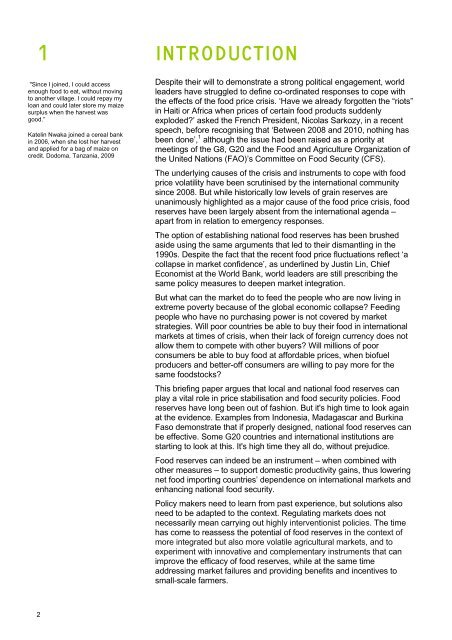Preparing for Thin Cows - Oxfam International
Preparing for Thin Cows - Oxfam International
Preparing for Thin Cows - Oxfam International
- No tags were found...
You also want an ePaper? Increase the reach of your titles
YUMPU automatically turns print PDFs into web optimized ePapers that Google loves.
1 INTRODUCTION"Since I joined, I could accessenough food to eat, without movingto another village. I could repay myloan and could later store my maizesurplus when the harvest wasgood.”Katelin Nwaka joined a cereal bankin 2006, when she lost her harvestand applied <strong>for</strong> a bag of maize oncredit. Dodoma, Tanzania, 2009Despite their will to demonstrate a strong political engagement, worldleaders have struggled to define co-ordinated responses to cope withthe effects of the food price crisis. ‘Have we already <strong>for</strong>gotten the “riots”in Haiti or Africa when prices of certain food products suddenlyexploded?’ asked the French President, Nicolas Sarkozy, in a recentspeech, be<strong>for</strong>e recognising that ‘Between 2008 and 2010, nothing hasbeen done’, 1 although the issue had been raised as a priority atmeetings of the G8, G20 and the Food and Agriculture Organization ofthe United Nations (FAO)’s Committee on Food Security (CFS).The underlying causes of the crisis and instruments to cope with foodprice volatility have been scrutinised by the international communitysince 2008. But while historically low levels of grain reserves areunanimously highlighted as a major cause of the food price crisis, foodreserves have been largely absent from the international agenda –apart from in relation to emergency responses.The option of establishing national food reserves has been brushedaside using the same arguments that led to their dismantling in the1990s. Despite the fact that the recent food price fluctuations reflect ‘acollapse in market confidence’, as underlined by Justin Lin, ChiefEconomist at the World Bank, world leaders are still prescribing thesame policy measures to deepen market integration.But what can the market do to feed the people who are now living inextreme poverty because of the global economic collapse? Feedingpeople who have no purchasing power is not covered by marketstrategies. Will poor countries be able to buy their food in internationalmarkets at times of crisis, when their lack of <strong>for</strong>eign currency does notallow them to compete with other buyers? Will millions of poorconsumers be able to buy food at af<strong>for</strong>dable prices, when biofuelproducers and better-off consumers are willing to pay more <strong>for</strong> thesame foodstocks?This briefing paper argues that local and national food reserves canplay a vital role in price stabilisation and food security policies. Foodreserves have long been out of fashion. But it's high time to look againat the evidence. Examples from Indonesia, Madagascar and BurkinaFaso demonstrate that if properly designed, national food reserves canbe effective. Some G20 countries and international institutions arestarting to look at this. It's high time they all do, without prejudice.Food reserves can indeed be an instrument – when combined withother measures – to support domestic productivity gains, thus loweringnet food importing countries’ dependence on international markets andenhancing national food security.Policy makers need to learn from past experience, but solutions alsoneed to be adapted to the context. Regulating markets does notnecessarily mean carrying out highly interventionist policies. The timehas come to reassess the potential of food reserves in the context ofmore integrated but also more volatile agricultural markets, and toexperiment with innovative and complementary instruments that canimprove the efficacy of food reserves, while at the same timeaddressing market failures and providing benefits and incentives tosmall-scale farmers.2
















